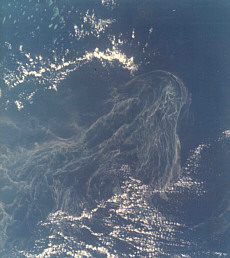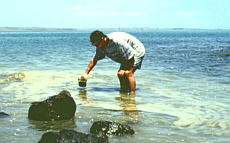Photo NASA
Getting sick of the increasingly aromatic low tides and of swimming through slicks of smelly 'sea dust'? One consolation to keep in mind is that to marine ecosystems, this particular ocean phenomenon is probably a major contributor of an essential nutrient - Nitrogen (N).
These slicks are made up of masses of blue-green algae called Trichodesmium. The algal cells can join up to each other in strings and clumps. As the cells age they become positively buoyant and rise to the surface. If it is calm, these cells get the opportunity to aggregate into huge slicks that are sometimes so vast they are visible from space.
The algae do not survive for long in these surface concentrations for various reasons, including damage caused by UV radiation, and soon start to go 'on the nose'.
The colours of the slick can be vivid due to the photosynthetic pigments in the algae, including chlorophyll that is green, and phycoerythrin that is purple. These coloured pigments absorb the sunlight energy that drives photosynthesis.
Nitrogen is essential to life. While nitrogen gas is abundant in air, it is not available to most plants and animals in that particular form. Trichodesmium deserve our respect because they are 'nitrogen fixers'- this means that they can take nitrogen gas from air and 'fix' it in a form that can then be transferred into the food chain. There is a strong suspicion among experts that a major source of nitrogen for marine ecosystems is that which comes via Trichodesmium. This input may even exceed the input from river runoff.
Photo AIMS
Unfortunately, the full significance of this phenomenon remains poorly understood because it is so tricky to study. Trichodesmium is impossible to culture for laboratory studies, and effective field observations are rare. While research efforts are underwayto redress this, the most useful observations remain those made by Captain Cook over 200 years ago!
Further information
Dr. Andrew Negri , AIMS; Phone: +61 7 4753 4322
Libby Evans-Illidge , AIMS; Phone: +61 7 4753 4426



